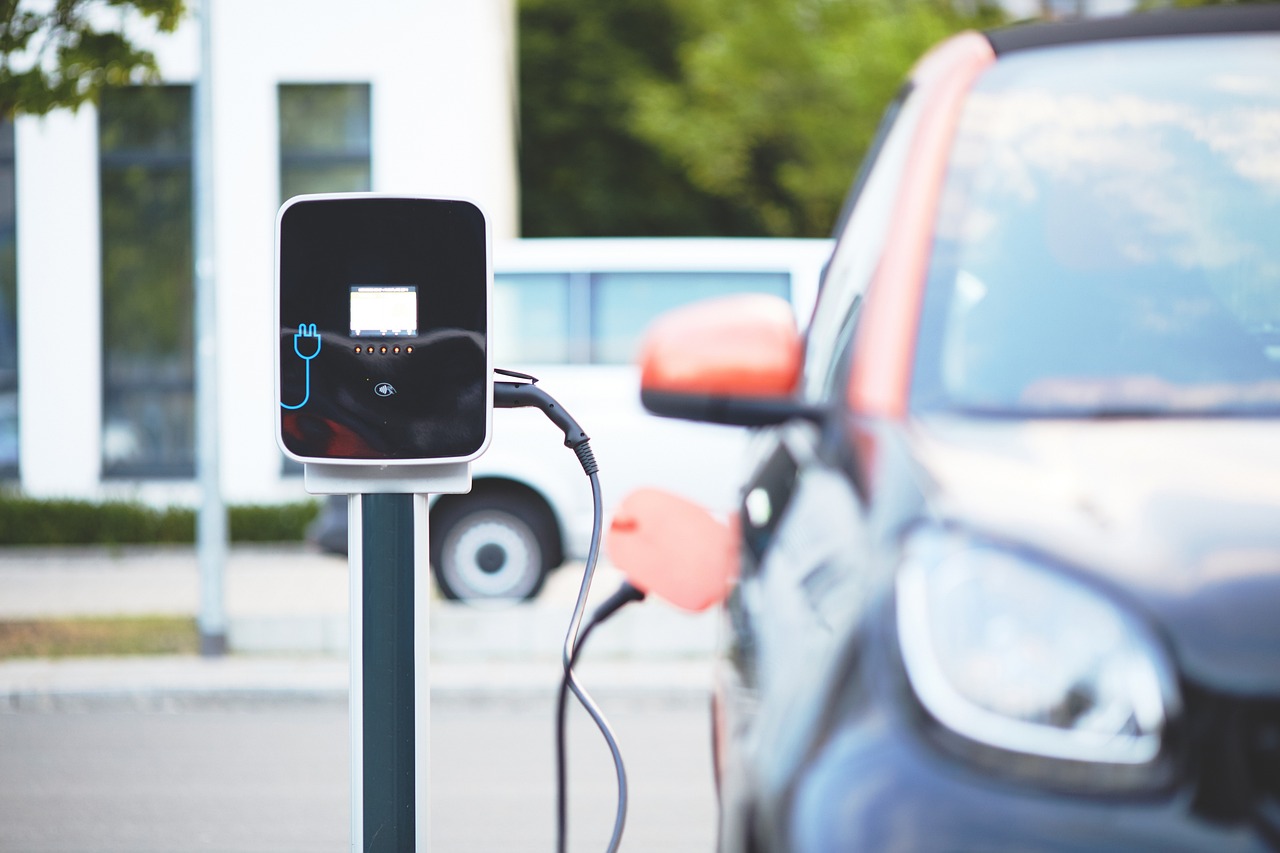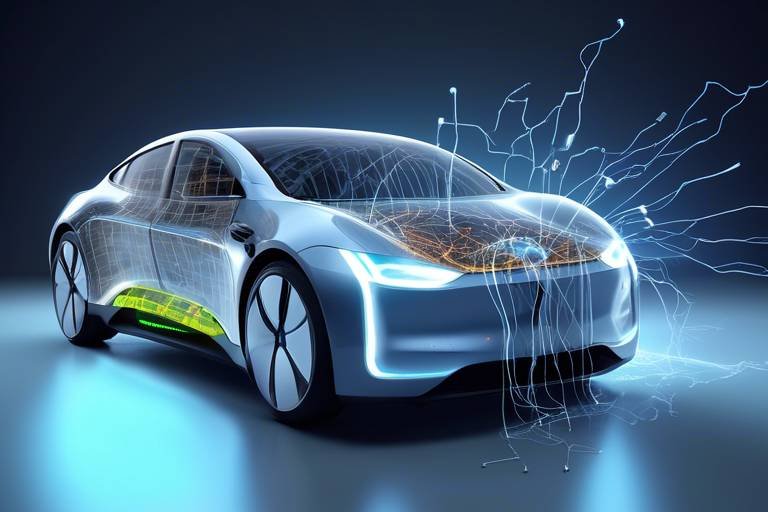The Physics of Electric Vehicles - How They Work
Electric vehicles (EVs) are revolutionizing the way we think about transportation, combining innovation with sustainability. But have you ever wondered how these amazing machines actually work? At the core of their functionality lies a fascinating interplay of physics and engineering principles that enable them to operate efficiently and reduce our carbon footprint. Let’s dive into the mechanics of EVs and uncover the secrets behind their operation.
First off, it’s essential to understand that electric vehicles rely on electric motors to convert electrical energy into mechanical energy. Unlike traditional internal combustion engines that burn fuel to create motion, electric motors use electromagnetic fields to generate torque. This means that EVs can deliver power instantly, providing a smooth and responsive driving experience. Imagine pressing the accelerator and feeling the immediate surge of power—it's like having a turbo boost at your fingertips!
One of the standout features of electric motors is their efficiency. They can achieve efficiencies of over 90%, compared to the 20-30% efficiency typical of gasoline engines. This means that a greater proportion of the energy stored in the batteries is converted into motion rather than wasted as heat. Furthermore, electric motors have fewer moving parts, which not only reduces maintenance needs but also contributes to a quieter ride. Now, who wouldn't want a car that’s both powerful and whisper-quiet?
Speaking of energy, let’s talk about the batteries that power these electric vehicles. The heart of any EV is its battery pack, which stores the electrical energy needed for propulsion. Most modern EVs utilize lithium-ion batteries, known for their high energy density and long lifespan. These batteries can store a substantial amount of energy in a relatively small space, making them ideal for automotive applications. However, the chemistry of these batteries is crucial; it affects not only how much energy they can hold but also how quickly they can be charged and discharged.
Electric motors are the unsung heroes of the EV world. They come in various types, such as brushed and brushless motors, each with its own advantages. Brushless motors, for example, are more efficient and have a longer lifespan compared to their brushed counterparts. This efficiency translates to better performance and range for the vehicle, allowing drivers to go further on a single charge. It’s like having a marathon runner instead of a sprinter—both are fast, but one can go the distance!
Now, let's get into the nitty-gritty of batteries. The energy storage system is not just about holding power; it’s about how that power is managed and utilized. The chemistry behind the batteries—primarily lithium-ion—plays a significant role in determining their performance. Lithium-ion batteries are favored for their ability to charge quickly and discharge efficiently. They are composed of various materials that work together to facilitate the transfer of ions, which is how energy is stored and released. Think of it as a dance where each element has a role to play, ensuring that everything runs smoothly.
The chemistry of batteries is a complex but fascinating topic. Different battery types, such as lithium iron phosphate and nickel cobalt manganese, have unique properties that affect their energy capacity, lifespan, and safety. Here’s a quick comparison:
| Battery Type | Energy Density | Safety | Cost |
|---|---|---|---|
| Lithium-Ion | High | Moderate | Moderate |
| Lithium Iron Phosphate | Lower | High | Higher |
| Nickel Cobalt Manganese | Very High | Moderate | High |
This table illustrates the trade-offs between energy density, safety, and cost, which are essential considerations for manufacturers and consumers alike.
Charging systems also play a vital role in the usability of electric vehicles. Whether it’s home charging, fast charging at a station, or the innovative wireless charging technologies, the method of charging can significantly impact the convenience of owning an EV. Home charging is the most straightforward, allowing you to plug in overnight and wake up to a full battery. Fast charging stations, on the other hand, can replenish your battery in a fraction of the time, making long road trips more feasible. It’s like having a coffee break—quick and energizing!
Battery management systems (BMS) are the guardians of EV batteries, ensuring their safe and efficient operation. They monitor battery health, optimize performance, and prolong lifespan, much like a personal trainer guiding you through a workout. A well-functioning BMS can prevent issues like overcharging or overheating, which could otherwise lead to battery failure. This level of oversight is crucial for maintaining the reliability and safety of electric vehicles.
Have you ever heard of regenerative braking? It’s one of the coolest features of electric vehicles! This technology captures energy that would otherwise be lost during braking and feeds it back into the battery. Imagine riding a bicycle downhill; you don’t just coast down, but you also harness some of that energy to keep moving forward. That’s precisely what regenerative braking does for EVs, enhancing their energy efficiency and extending their range.
When it comes to energy efficiency, electric vehicles are designed with several factors in mind. Aerodynamics, weight, and tire performance all play critical roles in how much energy an EV consumes. For instance, a sleek, aerodynamic design reduces drag, allowing the vehicle to glide through the air with minimal resistance. Similarly, lightweight materials help improve efficiency, making it easier for the motor to propel the vehicle. It’s like a well-oiled machine, where every part contributes to the overall performance.
Comparing the energy efficiency of EVs to traditional vehicles reveals significant environmental benefits. On average, electric vehicles produce fewer emissions and consume less energy per mile traveled. This comparison highlights the potential of EVs to reduce our reliance on fossil fuels and combat climate change. It’s not just about saving money on gas; it’s about making a positive impact on our planet!
The future of electric vehicles is bright, with continuous advancements in technology and infrastructure. Innovations in battery technology, such as solid-state batteries, promise even greater efficiency and safety. However, challenges such as charging infrastructure and battery recycling remain. As we move towards a more sustainable transportation system, electric vehicles will play a crucial role in shaping our future. They are not just a trend; they are the future of mobility!
- What is the average range of an electric vehicle? Most modern EVs can travel between 150 to 370 miles on a single charge, depending on the model and battery capacity.
- How long does it take to charge an electric vehicle? Charging time varies based on the charger type. Level 1 chargers can take several hours, while fast chargers can recharge an EV in about 30 minutes.
- Are electric vehicles really better for the environment? Yes! Electric vehicles produce fewer greenhouse gas emissions compared to traditional gasoline vehicles, especially when charged using renewable energy sources.

Understanding Electric Motors
Electric motors are the heart of electric vehicles (EVs), acting as the vital component that converts electrical energy into mechanical energy. But how exactly does this transformation take place? At its core, an electric motor operates on the principles of electromagnetism. When electricity flows through a coil of wire within a magnetic field, it generates a force that causes the motor to turn. This process is not only efficient but also remarkably simple compared to the intricate workings of traditional internal combustion engines.
One of the most significant advantages of electric motors is their efficiency. While internal combustion engines convert only about 20% of the energy stored in fuel into usable power, electric motors can achieve efficiencies exceeding 90%. This means that more of the energy stored in the vehicle’s batteries is utilized for propulsion, resulting in less energy waste and lower operational costs. Imagine driving a car where almost every ounce of energy contributes to moving you forward – that’s the magic of electric motors!
Moreover, electric motors provide instant torque, which translates to rapid acceleration. When you press the accelerator in an electric vehicle, the motor responds immediately, delivering power without the lag often experienced in gasoline engines. This characteristic not only enhances the driving experience but also contributes to the overall performance of the vehicle. You can think of it as having a sports car that is always ready to go, without the need to rev up first.
There are various types of electric motors used in EVs, each with its unique advantages:
- DC Motors: These are simpler and cheaper, making them suitable for smaller applications.
- AC Induction Motors: Known for their durability and efficiency, these are commonly used in many electric vehicles.
- Permanent Magnet Motors: These provide high efficiency and performance, often found in high-end electric vehicles.
In addition to their efficiency and performance, electric motors are also relatively low maintenance. Unlike traditional engines, they have fewer moving parts, which means there’s less that can go wrong. This aspect not only reduces the cost of ownership but also extends the lifespan of the vehicle. In a world where maintenance can be a hassle, the simplicity of electric motors is a breath of fresh air!
As we look toward the future, the development of electric motors continues to evolve. Innovations in materials, design, and manufacturing processes promise to enhance their efficiency and reduce costs even further. With advancements in technology, we can expect electric motors to become even more powerful and efficient, paving the way for a new era of sustainable transportation.

Batteries and Energy Storage
Batteries are the lifeblood of electric vehicles (EVs), acting as the primary source of energy that powers these innovative machines. Unlike traditional vehicles that rely on gasoline or diesel, EVs harness the power of electricity stored in batteries, making them not only more efficient but also more environmentally friendly. The technology behind these batteries is nothing short of fascinating, as it combines chemistry, physics, and engineering to create a system that can store and release energy effectively. In essence, batteries in EVs are like a reservoir of potential energy, waiting to be unleashed to propel the vehicle forward.
Different types of batteries are utilized in electric vehicles, with lithium-ion batteries being the most common. These batteries are favored for their high energy density, lightweight nature, and ability to recharge quickly. However, the world of battery technology is constantly evolving, and new contenders are emerging, such as solid-state batteries, which promise even greater efficiency and safety. Understanding the differences between these battery types is crucial for grasping how they impact the performance and longevity of electric vehicles.
The chemistry behind batteries significantly influences their efficiency and lifespan. Lithium-ion batteries, for instance, operate on the principle of lithium ions moving between the anode and cathode during charge and discharge cycles. This movement creates a flow of electricity, powering the vehicle. On the other hand, solid-state batteries replace the liquid electrolyte with a solid one, reducing the risk of leaks and fires while potentially offering higher energy densities. This advancement could revolutionize the EV market, making vehicles not only more efficient but also safer.
Charging systems are essential for the practicality of electric vehicles. There are several methods available for charging EV batteries, each with its unique advantages and considerations. Home charging is the most convenient option for many users, allowing them to recharge their vehicles overnight. Fast charging stations, often found along highways, enable drivers to quickly charge their batteries during long trips, providing a significant boost in convenience. Moreover, the emerging technology of wireless charging is paving the way for even more seamless charging experiences, allowing vehicles to charge without the need for physical connections.
Battery management systems (BMS) are the unsung heroes of electric vehicles. These systems monitor the health of the battery, ensuring it operates within safe parameters. They play a vital role in optimizing performance by balancing the charge across individual cells, which helps to prolong battery life. Think of the BMS as the brain of the battery, constantly analyzing data and making adjustments to keep everything running smoothly. This technology not only enhances the efficiency of the vehicle but also provides peace of mind to the driver, knowing that their battery is being well cared for.
One of the standout features of electric vehicles is regenerative braking, which contributes significantly to energy efficiency. During braking, instead of wasting energy as heat like traditional brakes, EVs use regenerative braking to convert kinetic energy back into electrical energy. This energy is then fed back into the battery, effectively recharging it while slowing down the vehicle. It's a brilliant cycle that showcases the ingenuity of electric vehicle technology, turning what would typically be a loss of energy into a valuable resource.
In summary, the batteries and energy storage systems in electric vehicles are not just functional components; they are integral to the overall efficiency and sustainability of EVs. As technology advances, we can expect to see even more improvements in battery chemistry, charging mechanisms, and management systems, all contributing to a greener future.
- What type of batteries are used in electric vehicles?
The most common type of battery used in electric vehicles is the lithium-ion battery, although solid-state batteries are emerging as a promising alternative.
- How long does it take to charge an electric vehicle?
Charging times vary based on the charging method used. Home charging can take several hours, while fast charging stations can recharge a battery to 80% in about 30 minutes.
- What is regenerative braking?
Regenerative braking is a technology that allows electric vehicles to recover energy during braking, converting it back into electrical energy to recharge the battery.
- How does a battery management system work?
A battery management system monitors the health and performance of the battery, ensuring it operates safely and efficiently by balancing charge across cells.

Battery Chemistry
When it comes to electric vehicles (EVs), the heart of their energy storage system lies in the . Understanding how these batteries work is crucial to appreciating their performance and longevity. The most commonly used battery type in EVs is the lithium-ion battery, which has revolutionized the way we think about energy storage. But why lithium-ion? Well, it’s all about the balance between energy density, efficiency, and lifespan.
Lithium-ion batteries operate on the principle of intercalation, where lithium ions move between the anode and cathode during charging and discharging cycles. This movement of ions is what generates the electrical current needed to power the vehicle. One of the standout features of lithium-ion batteries is their high energy density, which means they can store a lot of energy in a relatively small space. This is why you can find EVs with impressive ranges that make them practical for everyday use.
However, not all lithium-ion batteries are created equal. They come in various chemistries, each with its own set of advantages and limitations. The most common lithium-ion chemistries include:
- Lithium Nickel Manganese Cobalt (NMC): Known for its balance of performance and safety, NMC batteries are widely used in many electric vehicles.
- Lithium Iron Phosphate (LiFePO4): These batteries are praised for their thermal stability and safety, making them ideal for applications where safety is a priority.
- Lithium Cobalt Oxide (LCO): While offering high energy density, LCO batteries are often used in consumer electronics rather than EVs due to cost and stability concerns.
In recent years, the development of solid-state batteries has emerged as a game-changer in the EV market. Unlike traditional lithium-ion batteries that use liquid electrolytes, solid-state batteries utilize solid electrolytes, which can lead to higher energy densities and improved safety. Imagine a battery that not only lasts longer but is also less prone to catching fire—sounds like a dream, right? Well, it's becoming a reality!
But let’s not forget about the environmental impact of battery production and disposal. The extraction of lithium and other materials has raised concerns about sustainability and ecological damage. As the demand for electric vehicles grows, so does the need for responsible sourcing and recycling of battery materials. This is where innovations in battery recycling technologies come into play, aiming to reduce waste and recover valuable materials for reuse.
In conclusion, the chemistry behind EV batteries is a fascinating blend of science and technology. With advancements in materials and recycling processes, the future looks bright for battery technology in electric vehicles. As we continue to innovate, the hope is to create batteries that not only power our vehicles efficiently but also do so sustainably.
Q: What is the lifespan of a lithium-ion battery in an electric vehicle?
A: Typically, a lithium-ion battery can last between 8 to 15 years, depending on usage and maintenance.
Q: Are solid-state batteries better than lithium-ion batteries?
A: Solid-state batteries offer higher energy density and improved safety, but they are still in the development phase for widespread use in EVs.
Q: How are electric vehicle batteries recycled?
A: EV batteries are recycled through processes that recover valuable materials, such as lithium, cobalt, and nickel, for reuse in new batteries.

Charging Mechanisms
Charging mechanisms are a critical aspect of electric vehicles (EVs), enabling them to recharge their batteries and maintain optimal performance. The convenience and efficiency of these charging methods can significantly influence the overall usability of EVs. Let's dive into the various charging options available today, which can be broadly categorized into three main types: home charging, fast charging, and wireless charging.
First up is home charging. This is the most common method for EV owners, allowing them to recharge their vehicles overnight while they sleep. Typically, this involves installing a Level 2 charging station at home, which can deliver about 240 volts of electricity. With this setup, an EV can gain approximately 25 miles of range per hour of charging. Imagine waking up every morning to a fully charged vehicle, ready to take you wherever you need to go! However, the initial installation cost can be a consideration for many.
Next, we have fast charging, which is a game-changer for longer trips. Fast charging stations, often found along highways and in public areas, can provide a significant boost of power to an EV in a short amount of time. These stations can deliver DC fast charging, which can charge an EV up to 80% in just 30 minutes! This means that you can grab a coffee or snack while your car charges, making it a convenient option for road trips. However, the availability of fast charging stations can vary greatly depending on your location, which might lead to some planning ahead.
Lastly, there's the innovative technology of wireless charging. While still in its early stages, this method eliminates the need for plugging in your vehicle. Instead, it uses electromagnetic fields to transfer energy from a charging pad on the ground to a receiver on the vehicle. This technology is akin to how your smartphone charges on a wireless pad, making it incredibly user-friendly. Imagine driving your car over a charging pad and letting it charge without any hassle! However, the infrastructure for wireless charging is still being developed and isn't widely available just yet.
To summarize the different charging mechanisms, take a look at this table:
| Charging Type | Charging Time | Location |
|---|---|---|
| Home Charging | 8-12 hours | Residential |
| Fast Charging | 30 minutes to 1 hour | Public Stations |
| Wireless Charging | Varies | Future Infrastructure |
Understanding these charging mechanisms is essential for any potential EV owner. As charging technology continues to evolve, we can expect even more efficient and convenient methods to emerge, making electric vehicles increasingly appealing. So, whether you’re charging at home, stopping for a quick fast charge, or dreaming of the day wireless charging becomes the norm, one thing is clear: the future of EV charging is bright!
- How long does it take to charge an electric vehicle? Charging time varies based on the type of charger used. Home charging can take several hours, while fast charging can replenish up to 80% of battery capacity in about 30 minutes.
- Are there enough charging stations available? The availability of charging stations is improving rapidly, but it can vary by region. It's advisable to plan your route ahead of time, especially for long trips.
- Is wireless charging safe for electric vehicles? Yes, wireless charging is designed to be safe and efficient. It uses electromagnetic fields to transfer energy, similar to how wireless phone chargers work.

Battery Management Systems
Battery Management Systems (BMS) are the unsung heroes behind the scenes in electric vehicles (EVs). Think of a BMS as the brain of the battery, orchestrating its performance and ensuring everything runs smoothly. Without a BMS, the battery could become a ticking time bomb, leading to inefficiency and safety hazards. So, what exactly does a BMS do? Well, it monitors the health of the battery, manages energy flow, and optimizes performance to prolong its lifespan.
One of the primary functions of a BMS is to keep track of the battery's state of charge (SoC) and state of health (SoH). The SoC indicates how much energy is left in the battery, while the SoH provides insights into the battery's overall condition. By continuously assessing these parameters, the BMS can make real-time adjustments to charging and discharging processes, ensuring that the battery operates within safe limits. This is crucial because overcharging or deep discharging can significantly shorten a battery's lifespan.
Moreover, a BMS plays a vital role in thermal management. Batteries generate heat during operation, and excessive temperatures can lead to performance degradation or even catastrophic failure. The BMS helps to regulate the temperature by controlling cooling systems or adjusting the charging rate based on thermal conditions. This feature is especially important during fast charging, where the battery is more susceptible to overheating.
Another fascinating aspect of a BMS is its ability to balance the cells within a battery pack. Most EV batteries are made up of multiple cells, and these cells can age at different rates. A BMS ensures that all cells are charged and discharged evenly, preventing any one cell from becoming a weak link. This balancing act not only enhances performance but also maximizes the overall capacity of the battery pack.
In summary, the Battery Management System is an essential component of electric vehicles, ensuring safety, efficiency, and longevity of the battery. It acts as a guardian, monitoring the health of the battery, managing energy flow, and maintaining optimal operating conditions. As technology continues to evolve, we can expect even more advanced BMS solutions that will further enhance the performance and sustainability of electric vehicles.
- What is the main function of a Battery Management System?
The main function of a BMS is to monitor and manage the health and performance of the battery, ensuring safe operation and prolonging its lifespan. - How does a BMS improve battery safety?
A BMS improves battery safety by preventing overcharging, deep discharging, and overheating, which can lead to battery failure or fire. - Can a BMS extend the life of an electric vehicle battery?
Yes, by managing charge cycles and balancing cells, a BMS can significantly extend the life of an electric vehicle battery.

Regenerative Braking
Regenerative braking is one of the most fascinating features of electric vehicles (EVs), acting like a superhero that swoops in to save energy during a critical moment. When you think about traditional vehicles, they lose a significant amount of energy in the form of heat when braking. In contrast, EVs harness that energy, making the braking process not just a necessary action but also an opportunity for energy recovery. So, how does this work? Well, when you press the brake pedal in an EV, the electric motor that usually propels the vehicle switches roles and starts acting as a generator. This clever switch allows the motor to convert the kinetic energy of the car back into electrical energy.
Imagine you're riding a bicycle downhill. As you pedal, you build up speed, but when you apply the brakes, you slow down. In a traditional bike, that energy is just wasted. However, if your bike had a regenerative braking system, it would capture some of that energy as you slow down, storing it for later use. In the case of electric vehicles, this process is not only efficient but also contributes to extending the driving range. The energy captured during braking is sent back to the battery, which can then be used to power the vehicle again, thus enhancing overall efficiency.
Now, let’s break it down a bit more. The effectiveness of regenerative braking can be influenced by various factors, including:
- Speed: Higher speeds generally allow for more energy recovery.
- Battery State of Charge: If the battery is full, there’s less room to store recovered energy.
- Road Conditions: Wet or slippery roads may limit the effectiveness of regenerative braking.
While regenerative braking is a fantastic feature, it’s important to note that it doesn’t completely replace traditional braking systems. EVs still rely on friction brakes for sudden stops and at lower speeds. However, the combination of both systems ensures a smooth and effective braking experience. This dual approach not only maximizes energy efficiency but also enhances safety, giving drivers peace of mind.
As the technology behind regenerative braking continues to evolve, we can expect even greater efficiency gains. Innovations in battery technology and motor design will likely lead to improved energy recovery rates, making electric vehicles not just a sustainable choice but also a more practical one for everyday use. In the future, we may even see vehicles that can recover energy from every stoplight or traffic jam, turning what used to be a waste of energy into a valuable resource.
- What is regenerative braking? Regenerative braking is a technology used in electric vehicles that captures energy during braking and converts it back into electrical energy, which is then stored in the battery.
- How much energy can be recovered through regenerative braking? The amount of energy recovered varies depending on speed, battery state of charge, and road conditions, but it can significantly enhance the overall efficiency of the vehicle.
- Can regenerative braking replace traditional brakes? No, while regenerative braking helps recover energy, traditional friction brakes are still necessary for sudden stops and low-speed braking.

Energy Efficiency in EVs
Electric vehicles (EVs) are not just a trend; they represent a significant leap forward in how we think about transportation and energy consumption. One of the most remarkable features of EVs is their energy efficiency. Unlike traditional vehicles that rely on internal combustion engines, which waste a considerable amount of energy as heat, EVs convert a higher percentage of electrical energy from the grid to power at the wheels. In fact, EVs can convert over 60% of the electrical energy from the grid to power at the wheels, while conventional gasoline vehicles only convert about 20% of the energy stored in gasoline.
Several factors contribute to the energy efficiency of electric vehicles. Firstly, the aerodynamics of an EV plays a crucial role. A sleek design reduces air resistance, allowing the vehicle to glide through the air with minimal effort. This means less energy is required to maintain speed, which is particularly beneficial at higher velocities. Secondly, the weight of the vehicle significantly affects its energy consumption. EV manufacturers are increasingly using lightweight materials, such as aluminum and carbon fiber, to reduce overall vehicle weight, thus enhancing efficiency.
Another important aspect is the performance of the tires. Low rolling resistance tires are designed specifically for EVs to minimize energy loss as the vehicle moves. These tires can improve the range of an electric vehicle by reducing the amount of energy needed to keep the car rolling. When combined with regenerative braking systems, which recover energy during braking, the overall efficiency of EVs can be significantly enhanced.
To illustrate the differences in energy consumption, consider the following table comparing the efficiency metrics of electric vehicles with traditional gasoline vehicles:
| Vehicle Type | Energy Conversion Efficiency | Typical Range (miles) | Emissions (gCO2/mile) |
|---|---|---|---|
| Electric Vehicle | 60-70% | 150-370 | 0 |
| Gasoline Vehicle | 20-30% | 300-400 | 250-400 |
This comparison highlights the substantial advantages of EVs not only in terms of energy efficiency but also in their potential to reduce greenhouse gas emissions. As we move towards a more sustainable future, the role of electric vehicles becomes increasingly critical. By optimizing energy use, EVs contribute to a cleaner environment and a more sustainable transportation system.
In summary, the energy efficiency of electric vehicles is a multifaceted topic influenced by design, materials, and technology. As advancements continue to emerge, we can expect even greater improvements in how efficiently these vehicles operate, making them an increasingly attractive option for consumers looking to reduce their carbon footprint and save on fuel costs.
- What is the average range of an electric vehicle? The average range can vary widely, but many modern EVs offer between 150 to 370 miles on a single charge.
- How do EVs compare to traditional vehicles in terms of maintenance? EVs typically require less maintenance than traditional vehicles since they have fewer moving parts, no oil changes, and less wear on brakes due to regenerative braking systems.
- Are electric vehicles more expensive to operate? While the initial purchase price may be higher, the lower cost of electricity compared to gasoline, along with reduced maintenance costs, often makes EVs cheaper to operate in the long run.

Comparative Efficiency
When we talk about the efficiency of electric vehicles (EVs), the comparison with traditional internal combustion engine (ICE) vehicles becomes inevitable. It's like comparing apples to oranges, but with a closer look, you realize that EVs not only hold their ground but often outperform their gasoline counterparts in numerous aspects. One of the most striking differences lies in the way these vehicles convert energy into motion. EVs can convert over 60% of the electrical energy from the grid to power at the wheels, whereas conventional gasoline vehicles only convert about 20% of the energy stored in gasoline into movement. This stark difference highlights the inherent efficiency of electric propulsion.
Moreover, the environmental impact of this efficiency is profound. With fewer moving parts and a simpler design, electric motors experience less wear and tear, which translates to lower maintenance costs and longer lifespans. The reduced energy consumption of EVs leads to a significant decrease in emissions, especially when charged from renewable sources. In fact, studies have shown that EVs can reduce greenhouse gas emissions by up to 50% compared to traditional vehicles over their lifetime, depending on the energy source used for charging.
To illustrate the comparative efficiency further, let’s look at a table that summarizes the energy consumption metrics of both vehicle types:
| Vehicle Type | Energy Conversion Efficiency | Greenhouse Gas Emissions (g CO2/km) |
|---|---|---|
| Electric Vehicle | 60-70% | 0-100 (depending on energy source) |
| Internal Combustion Engine | 20-30% | 150-250 |
This table clearly shows that while EVs are more efficient in converting energy to motion, they also produce significantly lower emissions. It's essential to consider that the efficiency of EVs can be further enhanced through various factors such as aerodynamics, vehicle weight, and tire performance. For instance, lightweight materials and streamlined designs can improve the overall energy consumption of electric vehicles, making them even more attractive in the quest for sustainable transportation.
In conclusion, when we weigh the scales of efficiency, electric vehicles not only shine in their energy conversion capabilities but also lead the charge towards a cleaner, greener future. It's a win-win situation — better performance, lower emissions, and a step closer to sustainability. As technology continues to evolve, we can only expect these numbers to improve, making EVs an even more compelling choice for the environmentally-conscious consumer.
- What is the main advantage of electric vehicles over traditional vehicles? Electric vehicles have a higher energy conversion efficiency, leading to lower operational costs and reduced emissions.
- How do electric vehicles reduce greenhouse gas emissions? EVs produce zero tailpipe emissions and can be charged using renewable energy sources, significantly lowering their overall carbon footprint.
- Are electric vehicles more expensive to maintain? Generally, EVs have lower maintenance costs due to fewer moving parts and less wear and tear compared to internal combustion engines.

The Future of Electric Vehicles
The future of electric vehicles (EVs) is not just bright; it’s practically blinding! As technology continues to evolve at a breakneck pace, the landscape of transportation is transforming in ways we could only dream of a decade ago. Imagine a world where the air is cleaner, the roads are quieter, and your car runs on energy that doesn’t deplete the planet. Exciting, right? Well, that future is closer than you think.
One of the most significant advancements on the horizon is the development of solid-state batteries. These batteries promise to deliver higher energy densities, faster charging times, and enhanced safety compared to traditional lithium-ion batteries. Picture this: a battery that could allow your EV to travel twice the distance on a single charge! This leap in battery technology could be the game-changer that makes electric vehicles more appealing to the average consumer.
Moreover, the integration of autonomous driving technology is set to redefine how we perceive transportation. Imagine sitting back and relaxing while your car navigates through traffic, making decisions on the fly. Companies like Tesla, Waymo, and others are pushing the boundaries of what's possible with self-driving technology. As these systems improve, we could see a significant reduction in accidents caused by human error, making our roads safer.
But it’s not just about the vehicles themselves. The infrastructure supporting EVs is also undergoing a revolution. Charging stations are sprouting up like daisies, making it easier than ever to charge your vehicle. The advent of wireless charging technology means that one day, you might be able to charge your car simply by parking over a charging pad. How convenient would that be? This seamless integration of charging solutions will undoubtedly encourage more people to make the switch from gasoline to electric.
However, the journey to a fully electrified future isn't without its challenges. Issues such as battery disposal and recycling, the sourcing of raw materials, and the need for a robust charging infrastructure are hurdles that must be addressed. Fortunately, innovations in recycling technologies and sustainable sourcing practices are already in development, aiming to mitigate these concerns. Collaboration between governments, manufacturers, and consumers will be vital in overcoming these obstacles.
Lastly, let’s not forget the role of policy and regulation in shaping the future of EVs. Many governments are setting ambitious targets for reducing carbon emissions and promoting electric vehicle adoption. Incentives such as tax breaks, rebates, and grants are making it financially easier for consumers to transition to electric. As public awareness grows and the demand for sustainable transportation increases, we can expect to see even more support for EV initiatives.
In summary, the future of electric vehicles is not just a trend; it’s a movement towards a more sustainable and efficient world. With advancements in battery technology, autonomous driving, charging infrastructure, and supportive policies, the road ahead is filled with promise. Are you ready to join the ride?
- What are the main advantages of electric vehicles?
Electric vehicles offer numerous benefits, including lower operating costs, reduced greenhouse gas emissions, and decreased reliance on fossil fuels. They also provide a quieter driving experience and require less maintenance than traditional combustion engine vehicles.
- How long does it take to charge an electric vehicle?
Charging time varies depending on the type of charger used. Level 1 chargers (standard home outlets) can take several hours, while Level 2 chargers can fully charge a vehicle in a few hours. Fast chargers can provide significant power in as little as 30 minutes.
- Are electric vehicles really better for the environment?
Yes, electric vehicles produce zero tailpipe emissions, which contributes to improved air quality. However, the overall environmental impact depends on how the electricity used to charge them is generated.
Frequently Asked Questions
- What are electric vehicles (EVs) and how do they work?
Electric vehicles (EVs) are cars that use electric motors powered by batteries instead of traditional internal combustion engines. They convert electrical energy stored in batteries into mechanical energy, allowing the vehicle to move. This process is highly efficient, reducing energy loss and emissions compared to gas-powered vehicles.
- What types of batteries are commonly used in EVs?
The most common type of battery used in electric vehicles is the lithium-ion battery. These batteries are favored for their high energy density and long lifespan. There are also emerging technologies like solid-state batteries, which promise even greater efficiency and safety.
- How does regenerative braking work in electric vehicles?
Regenerative braking is a technology that allows EVs to recover energy when slowing down. Instead of wasting energy as heat, the electric motor operates in reverse, converting kinetic energy back into electrical energy, which is then stored in the battery. This process enhances overall energy efficiency and extends the vehicle's range.
- What are the different charging methods for electric vehicles?
There are several charging methods for electric vehicles, including:
- Home charging: Using a standard outlet or a dedicated home charging station.
- Fast charging: Available at public charging stations, allowing for quicker battery replenishment.
- Wireless charging: An emerging technology that allows for charging without plugging in, using electromagnetic fields.
- What is a Battery Management System (BMS)?
A Battery Management System (BMS) is crucial for the safe and efficient operation of EV batteries. It monitors battery health, manages charging and discharging cycles, and optimizes performance to prolong battery lifespan. Essentially, it acts as the brain of the battery, ensuring everything runs smoothly.
- How do electric vehicles compare to traditional vehicles in terms of energy efficiency?
Electric vehicles are generally more energy-efficient than traditional gas-powered cars. They convert a higher percentage of electrical energy from the grid to power at the wheels. This efficiency translates into lower energy consumption and fewer emissions, making EVs a more sustainable choice for transportation.
- What does the future hold for electric vehicles?
The future of electric vehicles looks bright, with continuous advancements in technology, infrastructure, and battery efficiency. Innovations like improved charging solutions and autonomous driving capabilities are on the horizon. However, challenges such as charging infrastructure and battery recycling must be addressed to maximize their potential impact on sustainable transportation.



















